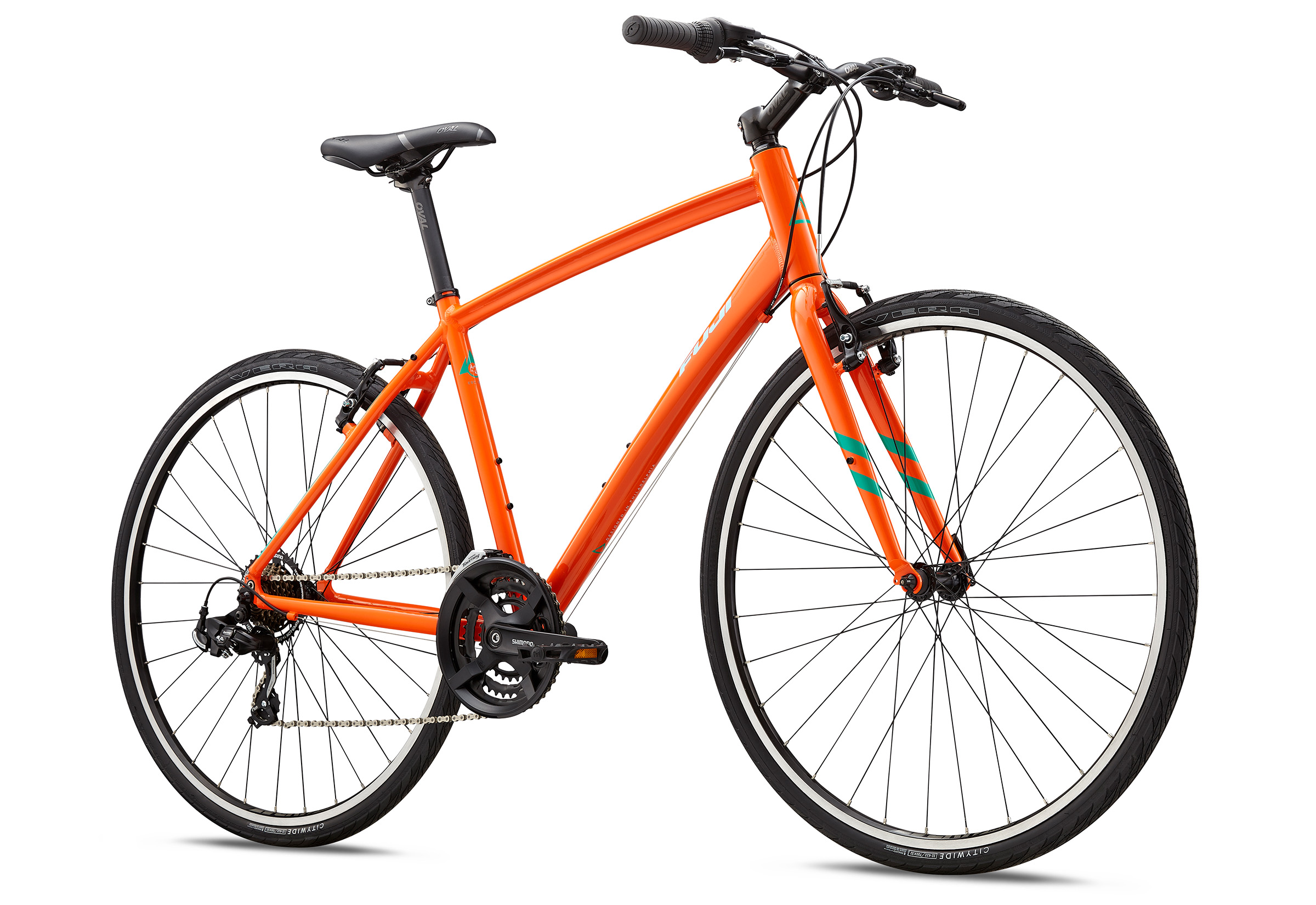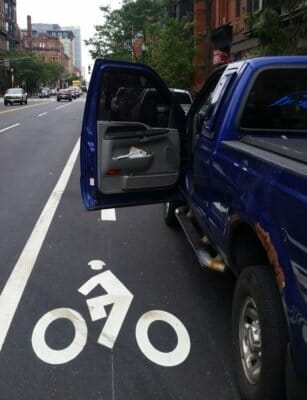In search of family recreation, a substitute for closed gyms, or a way of getting around when public transportation is unsafe, Americans are rediscovering the bicycle (again). The New York Times, NPR, CNN, and the Guardian have all taken note of the new bike boom, which is also occurring in Germany, the UK and probably other countries in response to the COVID-19 pandemic. There are lots of great reasons to start bicycling, including fun, fitness, and transportation. The reduction in car traffic during the pandemic has made streets more accessible.
There are still millions who have not yet acquired the equipment, information, and skills to make bicycling practical, enjoyable, and safe. Let’s fix that! I’m assuming you are an adult who knows how to balance and steer a bicycle, but who has minimal riding experience. I will walk you through what you need to know to get bicycling safely, comfortably, and efficiently.
A Beginner Bicycle
First you will need a bicycle! That has gotten harder now that everyone wants one at the same time. You might already have one that is suitable, or you might be able to get or buy a used one. There are some potential dealbreakers. If your candidate machine is not the right size, find another. How to tell? You know it’s too big if you can’t stand over the frame with both feet comfortably on the ground–and really there should be at least an inch or two of clearance. Too small is trickier to determine. The seat needs to be able to go high enough so that you can extend your leg almost completely at the bottom of the pedal stroke. You might also be too close to the handlebars.
A low quality bicycle is not worth your time and effort. Bicycles sold at stores such as Walmart and Target for under $300 are hard to adjust properly and not very durable. Any bike that has been unused for some time will likely need adjustment and part replacement that could cost $100-$200 at your local bike shop. That is a good investment for a decent-quality bicycle that fits and is generally suited to your needs–but otherwise not.
If you need to buy a bicycle, your local bike shop will likely have an array of options that is bewildering for the beginner. I recommend a bicycle intended for pavement use with an upright riding position–such as a “hybrid” (so-called because they are between road bikes with drop bars and mountain bikes designed for rough trails). These bicycles generally have flat or low-rise handlebars, front and rear derailleur gearing, and tires that are 32 to 38 mm (1.25 to 1.5 inches) wide. Confusingly, some brands label these as “cross” or “fitness” bicycles. Prices start around $400, but it may be difficult to find one in stock at that price.

There are a number of “features” on some bicycles that you should avoid, including suspension fork, an extremely wide saddle, knobby tires, and suspension seat post. All of these add weight or inefficiency without improving comfort. For these reasons, you should generally avoid “comfort” and “‘cruiser” style bicycles.
A note on handlebars: an upright position is the best starting place for beginners, but unfortunately most manufacturers use mostly-straight flat or riser bars derived from mountain bikes rather than the swept-back bars found on traditional utility bicycles, which provide a much more comfortable wrist position. It is often possible to replace handlebars. Grip or twist shifters require longer handlebars than thumb or trigger shift levers, so the latter gives you more replacement handlebar options. The swept-back design will reduce the reach to the bars, potentially making your posture more cramped, but this can be corrected by swapping the handlebar stem for one with a greater forward extension. Ask your bicycle shop about making a handlebar change when you are buying a bicycle.

A note on seats: wider, softer seats (or more properly, saddles) would seem to be more comfortable but they are more likely to induce chafing as you pedal. With any seat, the beginning bicyclist may experience some discomfort after the first ride or two, but this quickly disappears as your body gets used to riding.

Hybrid bikes will virtually always come with a wide range of gears and mounts for accessories. They can be made into a usable bike for transportation by adding a baggage rack, fenders, lights, and a bell (if you know this is your purpose, see the discussion below about transportation bicycles that come with these accessories).
Essential accessories
There are some items beside the bicycle that every bicyclist will need. These include:
- a floor pump
- a helmet
- water bottle and cage
- lock
- sunglasses
- smartphone holder
I strongly recommend getting an LED front and rear light set to carry even if you never intend to ride your bicycle after dark. Even with reflectors, bicycles are hard to see in the dark, and lights are cheap and highly effective.

Although they are not required, some bicyclists find that a rear-view mirror is helpful, particularly if they have difficulty turning their neck to see behind, or if they want to test if overtaking drivers are reacting properly. Helmet- or eyeglass-mounted mirrors are the most useful and practical design.
An important upgrade to your new bicycle is a set of mini pedal clips. These perform two extremely useful functions: (1) they let you easily raise your pedal into a high position for smooth starting from a stop and (2) they prevent your feet from sliding off, such as when pushing hard to climb a hill. They can be found for less than $10. Many pedals have a reflector that can be removed, revealing holes where the clips are mounted (if not, you will also have to replace your pedals). Check the pedals when you are buying a bicycle; the bicycle shop may agree to swap pedals at minimal cost.

An electric bike?
Thanks to improved batteries and miniaturized motors, pedal bicycles with electric power are widely available. They are especially useful for riders frequently carrying kids or cargo, confronting steep climbs, or both. Many electric bikes come with integrated battery-powered lighting. They are considerably more expensive and heavy than conventional bicycles and require recharging time. The slowest e-bikes are limited to 20 mph on electrical power alone, but can go faster when combined with pedaling.
I don’t recommend considering an e-bike until after you’ve put in substantial riding time on a regular bicycle. Higher speed and inexperience are a poor combination. Under your own power, you will develop stamina and riding skill together, practicing both climbing and descending skills.
Where Can I Ride Safely?
The most important element in bicycle safety is . . . you. Only 12% of bicyclists visiting an emergency department were involved with a crash with a motor vehicle. That shouldn’t be surprising– for example, half of passenger car fatalities are single-vehicle crashes.
So the prior question is, how can I ride safely? The short answer is: follow the same rules as drivers. It is very much worth your while to learn how this works in practice; the best way is to take a CyclingSavvy course. If in-person courses are not available, you can take an online class, currently available for half price. The Essentials Short Course is free. The CyclingSavvy Basics Course, $17.50, covers the rules of traffic and how bicyclists operate within them. Another excellent resource covering this material is John S. Allen’s Bicycling Street Smarts.
In brief, here are the things you must do to avoid causing a collision:
- Ride on the right half of the road, with, not against, traffic. Don’t ignore Do Not Enter signs.
- Do not move across the road without first checking that no one is coming.
- Look and yield before entering the road from a driveway.
- Yield to cross traffic when you have a red light, stop sign, or yield sign.
- Yield when you are turning left.
- Don’t pass on the right unless the driver ahead is signaling left.
- Don’t ride so close to parked cars that you could be hit by a suddenly opening door.
Yes, these rules should sound familiar–they are the same ones you use when you drive! But far too many people stop following them when they get on a bicycle. You must also learn basic bicycle handling skills such as starting and stopping, using gears, and looking over your shoulder. Practice in an empty parking lot first. Be aware of road hazards.
Practice your bicycling street skills in a low-traffic, residential area. If your home neighborhood is not suitable, take your bike to another one. Then gradually increase your range. Too many American cities have cul-de-sac residential neighborhoods surround by major roads with high volumes of fast traffic. Plot a route to avoid those roads, and only cross them at a traffic signal.
Bike lanes, bike paths, and sidewalks
Attempting to “stay out of traffic” does not necessarily make bicyclists safer. Don’t ride within range of parked cars, or pass on the right of a vehicle that could turn right, even if there is a bike lane. If you choose to ride on a sidewalk (where legal), you will need to expect to go more slowly than on the road, following sidewalk rules, or your risk will increase significantly. Identify and avoid hazards on sidewalks. Riding on sidewalks and paths next to roads increases the risk of colliding with turning and entering traffic at driveways and intersections, especially if you are facing opposite the flow of traffic on the road.
Well-designed bicycle paths are typically wider than sidewalks, have fewer surface hazards, and are generally not adjacent to roads. However, you must stop and yield at every road intersection and moderate your speed between intersections, especially when paths are crowded with pedestrians. And beware of bollards that are sometimes placed on paths near road crossings. Lastly, it is harder to practice social distancing on paths.

A Bicycle for Transportation
If you know you want to use your bike for getting around, not just for recreation, I recommend looking for a “city bike” (sometimes styled as “urban” or “commuter”). These models are more likely to be pre-equipped with fenders, rack, kick stand, and chain guard.
A note on frames: most city bikes have aluminum or steel frames. Either will do. Some manufacturers offer models in diamond, step-through, or mixte versions. The step-through frame makes getting on easy, and lets you ride in a skirt. The mixte is a French frame style that is between the two–and not too different from the sloping top tubes that have become fashionable on other bike styles.
A note on gears: city bikes are more likely to be offered with a limited number of gears, or even a single-speed. Most either have internal hub gears (which require little maintenance) and 3, 7, or 8 speeds or have a rear derailleur with 7 to 9 speeds, rather than the front and rear derailleurs typically found on a hybrid bicycle. Any of the 7 to 9 speed options should be sufficient for transportation purposes, unless you live in a hilly area or are looking for a bicycle that will double as a weekend machine (but you may soon want to obtain a road bike for that purpse–see below).
Although the handlebars on city models typically have some bend, few brands offer the swept-back design that offers the most comfort for upright bicycles. Some of the few models available with at least 7 speeds and swept-back bars are:
- Linus Roadster 7i, Mixte 7i, and Dutchi 7i
- Public Bikes D8i, V7i, C7i, M7i, V7, C7, M7
- Pure Cycles Classic 8 Speed
- Brooklyn Bicycle Co. Willow 7
- Electra Loft 7D and Loft 7I
- sixthreezero RideInThePark
- Bikes Direct Windsor Kensington 8
- BikesOnline Polygon Sierra Oosten
Although it does not come with completely swept-back bars, the KHS Manhattan Green 8e, has a sprung saddle, fenders, rack, and bell, for only $379 (if you can find one, of course). Velo Orange offers several upright handlebars that give a comfortable wrist position.
Integrated lighting. If you are riding a bicycle for transportation, you need front and rear lights. The most dependable option is an integrated lighting system powered by a dynohub–a generator built into the front wheel powered by pedaling and always available. Unfortunately retrofitting a bike with this system is expensive, and if you are looking for a bicycle that comes already equipped with one for less than $1,000 there are currently only the following choices:
- Breezer Uptown 8
- Electra Townie Commute 8D, Townie Original 7D EQ, Townie Original 3i EQ, and Townie Path 9D EQ
- Decathlon Hoprider 100, 500, or 900
The Uptown 8 is also one of the very few bicycles on the market with a fully enclosed chain case, which prevents your pants from touching the chain. Including internal gears, a rack, fenders, bell, and self-lock, the Uptown 8 is a good value for $799. The Electra Townie Commute 8D has all of the same features as the Uptown 8 except derailleur gearing and a partial chain cover. It also adds a front rack and lists for the same price. The “foot-forward” riding position may or may not suit you. The saddle seems too wide and heavy–but could easily be changed.
The three Hoprider models all have a partial chain cover, and, unlike all the other city models mentioned, have front and rear derailleurs providing a wide range and selection of gears. The Hoprider 100 is a very good deal for $649. The 500, for $100 more, adds an extra cog (3 x 8 gears instead of 3 x 7) and a front suspension, that in my opinion offers little benefit on paved roads and adds 2 lbs. The 900 has a brighter lighting system, hydraulic disc brakes, and a 9-speed cassette.

In addition to those mentioned, brands that offer urban bikes include Detroit Bikes, State Bicycles, Civia, Biria, Jamis, Fuji, and Momentum (Giant).
If you are a more experienced rider and you have longer distances to cover, you may prefer a transportation bicycle with drop bars. Most touring bicycles are well suited to this purpose, since they are designed to carry loads and accommodate fenders. The Italian bicycle builder Cinelli had a touring bike on sale for $700. The Public R24, $800, is a steel road bicycle that is pre-equipped with fenders and attachments for a baggage rack. Another option is the Windsor Tourist for $600. Many of these are sold out currently.
Fitness Bicycling
Bicycling is a great way to get in shape. You can gradually increase your effort to achieve aerobic fitness and then improve muscle strength. Bicycling is almost too efficient: you will soon be seeking climbs and longer distances. Fitness riding is most efficient using the traditional techniques and equipment of road bicycling: a rapid cadence of around 90 pedal strokes per minute and an aerodynamic riding posture using drop bars. The entrepreneurs behind Spinning, SoulCycle, and Peloton found that adapting the road bicycling tradition to indoor bicycling is popular and lucrative.
Outdoor bicycling doesn’t require membership fees, and is easier because wind helps with heat dissipation–like an air-cooled engine. You also get sunlight (which lets your body produce needed vitamin D) and you can see the world–more of it compared to walking and driving. During the pandemic, being outside is much safer, although it is still best to avoid group rides.
The first upgrade I recommend for fitness cycling is your clothing: cycling shorts, jersey, and gloves will greatly increase your comfort. The stiff soles of bike shoes improve power transmission and reduce foot problems. You can get bike shoes that can be used with standard pedals, but can also accept recessed cleats (SPD-style) if you later purchase clip-in pedals.
Even an inexpensive road bike will be far better suited to fitness riding than any mountain, hybrid, or city bike. In fact, a lower-priced road bicycle is likely to have features that will make it more usable, durable, and comfortable such as 32-spoke wheels, low gears, wider tires, and attachment points for racks and fenders.

What about swapping handlebars? Unfortunately switching the flat handlebars of your hybrid bike to drop bars is not simple, since drop bars use a different brake and gear shift system. A road bike will also be lighter and have a geometry more suited to fitness riding. Instead, buy a road bike for fair-weather fitness riding, and set up your hybrid as an all-weather, all-purpose transportation bicycle. Two bicycles are better than one!
A note on pedals: Some road bikes come without pedals, so you can pick your own style. Clip-in pedals, available in several styles, provide a better connection between your feet and the bicycle. You should practice using them in an empty parking lot until clipping out before stopping becomes automatic.
Happy pedaling!